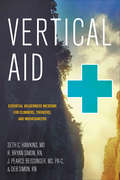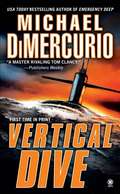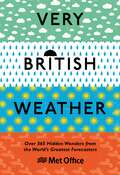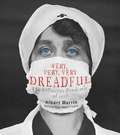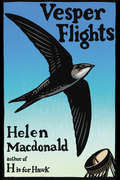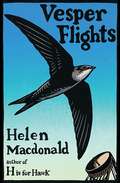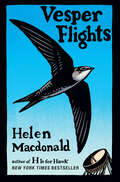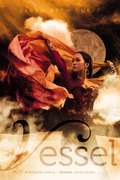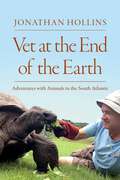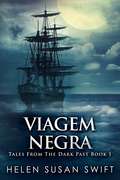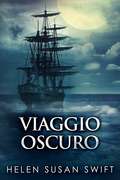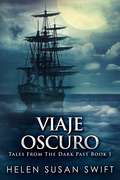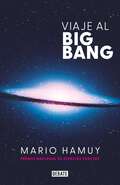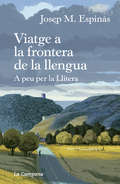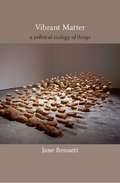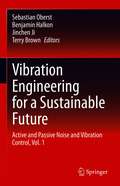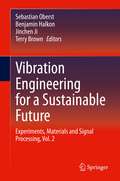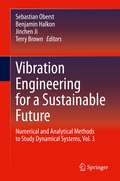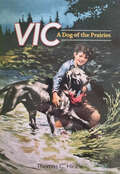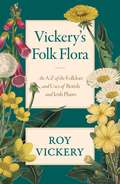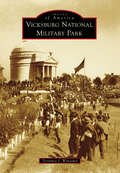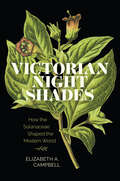- Table View
- List View
Vertical Aid: Essential Wilderness Medicine for Climbers, Trekkers, and Mountaineers
by Deb Simon J. Pearce Beissinger R. Bryan Simon Seth C. HawkinsA climbing medicine and wilderness first aid guidebook from a team of proven experts Climbing and mountaineering attracts millions of people around the world each year, but produces a unique set of challenges. The threat of danger is ever present, and professional medical help is often far away. Vertical Medicine Resources is a renowned climbing company providing medical training and consultation. In Vertical Aid, they have produced the most complete guide available for managing both emergencies and chronic injuries sustained during climbs. Researched and developed by professional healthcare providers and alpinists, the book includes helpful illustrations of common procedures and best practices, making it a practical and indispensable companion on any climbing, trekking, or alpine trip. It is replete with real-world-tested strategies, evidence-based medicine, and proven techniques. The diverse author team combines an EMS and emergency physician, a nurse, a physician assistant, and a nurse-trainer, who together have a profound depth of climbing, educational, and medical experience. With its unique combination of authoritative medical information and specific attention to the climbing environment, Vertical Aid is poised to become an authoritative resource for every climber, on every climb.
Vertical Dive
by Michael DimercurioDuring NATO exercises, the French Navy unveils Le Vigilant, a nuclear submarine so advanced that it can elude any radar system in the water. But France's maritime marvel is about to become its own worst enemy. A band of Algerian terrorists has hijacked Le Vigilant. They mean to wipe Paris and every major French city off the face of the earth-and then turn their missiles against the great Satans of the United States and Russia. Despite the French Navy's protests, two NATO subs are called into action: the USS Hampton, captained by veteran sub warrior Burke Dillinger, and the USS Texas, commanded by iron-willed Peter Vornado. Paris is being evacuated. Time is running out. And the coming conflict will pit the ultimate in technological weaponry against pure courage, skill, and determination....
Very British Weather: Over 365 Hidden Wonders from the World’s Greatest Forecasters
by The Met OfficeUPGRADE YOUR SMALL TALK GUIDED BY WORLD-LEADING WEATHER EXPERTS!From Foggy and Freezing to Scorching and Stormy, join the ultimate weather adventure through the great British seasons and uncover the extraordinary in every single day*.Are YOU the ultimate weather watcher?Do you know your drizzle from your mizzle?Ever wondered what rainbows are really made of?And could you pinpoint where lightning has struck twice?Pore over beautiful cloudscapes, learn the secrets of sunsets, discover freak weather and fogbows, and why forecasting was so important in British history, from D-Day to the Great Fire of London.Perfect for rainy days in or cloudspotting on the go, the Met Office share the best of almost 170 years of forecasting for the first time in this beautifully illustrated book. Packed with mythbusting, top trivia, stunning visuals and archive gems, shooting the breeze has never been so interesting!*Even when it is tipping it down.
Very Unusual Plants (Fountas & Pinnell Classroom, Guided Reading Grade 2)
by Charlotte MaloneNIMAC-sourced textbook
Very, Very, Very Dreadful: The Influenza Pandemic of 1918
by Albert MarrinFrom National Book Award finalist Albert Marrin comes a fascinating look at the history and science of the deadly 1918 flu pandemic--and the chances for another worldwide pandemic.In spring of 1918, World War I was underway, and troops at Fort Riley, Kansas, found themselves felled by influenza. By the summer of 1918, the second wave struck as a highly contagious and lethal epidemic and within weeks exploded into a pandemic, an illness that travels rapidly from one continent to another. It would impact the course of the war, and kill many millions more soldiers than warfare itself.Of all diseases, the 1918 flu was by far the worst that has ever afflicted humankind; not even the Black Death of the Middle Ages comes close in terms of the number of lives it took. No war, no natural disaster, no famine has claimed so many. In the space of eighteen months in 1918-1919, about 500 million people--one-third of the global population at the time--came down with influenza. The exact total of lives lost will never be known, but the best estimate is between 50 and 100 million. In this powerful book, filled with black and white photographs, nonfiction master Albert Marrin examines the history, science, and impact of this great scourge--and the possibility for another worldwide pandemic today.
Vesper Flights
by Helen MacdonaldFrom the bestselling author of H is for Hawk, a brilliant and insightful work about our relationship to the natural worldOur world is a fascinating place, teeming not only with natural wonders that defy description, but complex interactions that create layers of meaning. <P><P>Helen Macdonald is gifted with a special lens that seems to peer right through it all, and she shares her insights--at times startling, nostalgic, weighty, or simply entertaining--in this masterful collection of essays. From reflections on science fiction to the true story of an Iranian refugee's flight to the UK, Macdonald has a truly omnivorous taste when it comes to observations of both the banal and sublime. <P><P>Peppered throughout are reminisces of her own life, from her strange childhood in an estate owned by the Theosophical Society to watching total eclipses of the sun, visits to Uzbek solar power plants, eccentric English country shows, and desert hunting camps in the Gulf States. These essays move from personal experiences into wider meditations about love and loss and how we build the world around us. Whether more journalistic in tone, or literary--even formally experimental--each piece is generous, lyrical, and speaks to one another. <P><P>Macdonald creates a strong thematic undertow that quietly takes the reader along piece to piece and sets them down, finally, at a place they've never been before. <P><P><b>A New York Times Bestseller</b>
Vesper Flights
by Helen MacdonaldAnimals don't exist in order to teach us things, but that is what they have always done, and most of what they teach us is what we think we know about ourselves. In this book, the author brings together a collection of her best loved essays, along with new pieces on topics ranging from nostalgia for a vanishing countryside to the tribulations of farming ostriches to her own private vespers while trying to fall asleep. Meditating on notions of captivity and freedom, immigration and flight, the author invites us into her most intimate experiences: observing the massive migration of songbirds from the top of the Empire State Building, watching tens of thousands of cranes in Hungary, seeking the last golden orioles in Suffolk's poplar forests. She writes with heart-tugging clarity about wild boar, swifts, mushroom hunting, migraines, the strangeness of birds' nests, and the unexpected guidance and comfort we find when watching wildlife.
Vesper Flights
by Helen MacdonaldThe New York Times–bestselling author of H is for Hawk explores the human relationship to the natural world in this “dazzling” essay collection (Wall Street Journal).In Vesper Flights, Helen Macdonald brings together a collection of her best loved essays, along with new pieces on topics ranging from nostalgia for a vanishing countryside to the tribulations of farming ostriches to her own private vespers while trying to fall asleep.Meditating on notions of captivity and freedom, immigration and flight, Helen invites us into her most intimate experiences: observing the massive migration of songbirds from the top of the Empire State Building, watching tens of thousands of cranes in Hungary, seeking the last golden orioles in Suffolk’s poplar forests. She writes with heart-tugging clarity about wild boar, swifts, mushroom hunting, migraines, the strangeness of birds’ nests, and the unexpected guidance and comfort we find when watching wildlife.
Vessel
by Sarah Beth DurstIn a desert world of sandstorms and sand-wolves, a teen girl must defy the gods to save her tribe in this mystical, atmospheric tale from the author of Drink, Slay, Love.Liyana has trained her entire life to be the vessel of a goddess. The goddess will inhabit Liyana's body and use magic to bring rain to the desert. But Liyana's goddess never comes. Abandoned by her angry tribe, Liyana expects to die in the desert. Until a boy walks out of the dust in search of her. Korbyn is a god inside his vessel, and a trickster god at that. He tells Liyana that five other gods are missing, and they set off across the desert in search of the other vessels. For the desert tribes cannot survive without the magic of their gods. But the journey is dangerous, even with a god's help. And not everyone is willing to believe the trickster god's tale. The closer she grows to Korbyn, the less Liyana wants to disappear to make way for her goddess. But she has no choice: She must die for her tribe to live. Unless a trickster god can help her to trick fate--or a human girl can muster some magic of her own.
Vessel
by Sarah Beth DurstThis atmospheric fantasy is, "from the gripping first line, a fast-paced, thought-provoking, and stirring story of sacrifice" (Kirkus Reviews, starred review).Liyana has trained her entire life to be the vessel of a goddess. The goddess will inhabit Liyana's body and use magic to bring rain to the desert. But Liyana's goddess never comes. Abandoned by her angry tribe, Liyana expects to die in the desert. Until a boy walks out of the dust in search of her. Korbyn is a god inside his vessel, and a trickster god at that. He tells Liyana that five other gods are missing, and they set off across the desert in search of the other vessels. For the desert tribes cannot survive without the magic of their gods. But the journey is dangerous, even with a god's help. And not everyone is willing to believe the trickster god's tale. The closer she grows to Korbyn, the less Liyana wants to disappear to make way for her goddess. But she has no choice: She must die for her tribe to live. Unless a trickster god can help her to trick fate--or a human girl can muster some magic of her own.
Vet at the End of the Earth: Adventures with Animals in the South Atlantic
by Jonathan HollinsThe passionate story of a vet&’s care for all creatures great and small in the colorful, diverse, and distinctive South Atlantic islands.The role of a resident vet in the remote islands of the Falklands, St. Helena, Ascension, and Tristan da Cunha encompasses many wonderful complexities: caring for the world&’s oldest living land animal (a 200-year-old giant tortoise, denizen of the St. Helena governor&’s lawn); pursuing mystery creatures and invasive microorganisms; relocating herds of reindeer; and rescuing animals in extraordinarily rugged landscapes, from subtropical cloud forests to volcanic cliff faces. Hugely entertaining and affectionate, Jonathan Hollins&’s tales of island vet life are not only full of ingenuity and astounding fauna—they are also steeped in the unique local cultures, history, and peoples of the islands, far from the hustle of continental life. Come join Jonathan on his daily adventures with these alluring and fascinating creatures.
Viagem Negra
by Laís Alves Helen Susan SwiftÉ 1914, e medo e paranoia são regras em alto mar. Iain Cosgrove está recém-casado com Jennifer Manson, filha de um rico comerciante escocês. Mas Iain tem que sair numa busca a bordo do Lady Balgay, último dos grandes navios de Dundee. Cheio de rum e histórias de John Pratt, a tripulação fica obcecada com antigas superstições; algumas Iain simplesmente toma como simples crenças... até que eles alcançam o frio mar Ártico. Quando uma série de acidentes coincide com a aparição recorrente de uma mulher, as crenças de Iain ficam sobre um fio. Então, o navio encontra dois náufragos—um deles, uma mulher—e eventos tomam uma virada sinistra. Inspirado em lendas históricas, Viagem Negra é uma histórica persuasiva e horripilante que tomam lugar no gelado mar das águas do Norte.
Viaggio Oscuro
by Helen Susan SwiftÈ il 1914 e la paura domina l'alto mare. Iain Cosgrove si è appena sposato con Jennifer Manson, figlia di un ricco mercante scozzese. Iain deve partire il giorno dopo le nozze per un viaggio a bordo della Lady Balgay, l'ultima della grande flotta di navi per la caccia alle foche di Dundee. Alimentato dal rum e dai racconti di John Pratt, l'equipaggio è ossessionato da antiche superstizioni, quelle che Iain scarta casualmente come semplici leggende... finché non raggiungono il gelido Mar Glaciale Artico. Quando una serie di incidenti sembra coincidere con l'apparizione ricorrente di una figura femminile, le convinzioni di Iain sono scosse. Nel momento stesso in cui la nave accoglie due naufraghi - uno dei quali è una donna - gli eventi prendono una piega sinistra. Ispirato a racconti storici, Viaggio Oscuro è una storia avvincente e raccapricciante, ambientata nelle acque ghiacciate del nord.
Viaje Oscuro: Horror y misterio en los mares Árticos
by Helen Susan SwiftEs 1914, y el miedo y la paranoia gobiernan en alta mar. Iain Cosgrove está recién casado con Jennifer Manson, hija de un rico comerciante escocés. Pero Iain pronto debe partir para un viaje de investigación a bordo del Lady Balgay, el último de la antigua flota de cazadores de focas de Dundee. Impulsado por el ron y los cuentos de John Pratt, la tripulación se obsesiona con las antiguas supersticiones; los que Iain descarta casualmente como simples tradiciones ... hasta que alcanzan los fríos mares árticos. Cuando una serie de accidentes coinciden con la aparición recurrente de una aparición femenina, las creencias de Iain se ven sacudidas. Luego, el barco descubre dos náufragos, uno de ellos una mujer, y los eventos toman un giro siniestro. Inspirado en relatos históricos, Viaje Oscuro es una historia convincente y horrible ambientada en las aguas heladas del norte.
Viaje al Big Bang
by Mario HamuyEl destacado premio nacional de ciencias exactas nos explica la génesis y posterior evolución del universo. «¿Cómo es posible que, en mucho menos de un segundo, una explosión haya dado el puntapié inicial y fijado las leyes que regirían todo lo que vendría?» Esta, una de las preguntas más inquietantes elaboradas por la comunidad científica durante el siglo XX, es la que el prestigioso académico y divulgador científico Mario Hamuy intenta responder en este notable ensayo. Los astrónomos, de forma increíble, han logrado remontarse catorce mil millones de años al pasado y adentrarse en ese dramático segundo en el que se forjaron las condiciones iniciales de nuestro universo, nos asegura el autor de El sol negro. Desde allí, a partir de las propias leyes universales que el Big Bang se dio, se ha podido reconstruir su biografía y, de paso, la nuestra. Es así como hoy tenemos el privilegio de ser testigos de este momento clave de la humanidad, en el cual, por primera vez luego de muchos milenios contemplando e interrogando al cielo, nuestra especie puede comenzar a responder científicamente la pregunta ¿de dónde venimos los humanos?
Viatge a la frontera de la llengua: A peu per la Llitera
by Josep Maria EspinàsOn és exactament la Llitera? Com s'hi viu? Quin català es parla en aquesta comarca de l'Aragó? La passió per caminar i descobrir ha dut a Josep M. Espinàs, aquesta vegada, a una terra plena d'interrogants per a molta gent. On és exactament la Llitera? Quin català es parla en aquesta comarca de l'Aragó? La passió per caminar i descobrir va dur Josep M. Espinàs a una terra de pas plena d'interrogants per a molta gent. El 1990, caminant per la Llitera amb sol i amb tempestes, amb totes les sorpreses d'un viatge com aquest, Espinàs converteix l'experiència d'anar a peu en una narració viva, en una crònica que es llegeix com si el lector també s'aventurés amb l'escriptor per camins desconeguts. "Tota la Llitera a peu?, això no ho ha fet mai ningú!", li van dir els lliterans. Viatge a la frontera de la llengua és una obra excepcional en la literatura de viatges de Josep M. Espinàs, tant per l'escenari com pels fets que s'hi narren. Amb aquest llibre, l'autor aporta un testimoni directe i apassionat dels pobles de la comarca.
Vibrant Matter: A Political Ecology of Things
by Jane BennettIn Vibrant Matter the political theorist Jane Bennett, renowned for her work on nature, ethics, and affect, shifts her focus from the human experience of things to things themselves. Bennett argues that political theory needs to do a better job of recognizing the active participation of nonhuman forces in events. Toward that end, she theorizes a "vital materiality" that runs through and across bodies, both human and nonhuman. Bennett explores how political analyses of public events might change were we to acknowledge that agency always emerges as the effect of ad hoc configurations of human and nonhuman forces. She suggests that recognizing that agency is distributed this way, and is not solely the province of humans, might spur the cultivation of a more responsible, ecologically sound politics: a politics less devoted to blaming and condemning individuals than to discerning the web of forces affecting situations and events. Bennett examines the political and theoretical implications of vital materialism through extended discussions of commonplace things and physical phenomena including stem cells, fish oils, electricity, metal, and trash. She reflects on the vital power of material formations such as landfills, which generate lively streams of chemicals, and omega-3 fatty acids, which can transform brain chemistry and mood. Along the way, she engages with the concepts and claims of Spinoza, Nietzsche, Thoreau, Darwin, Adorno, and Deleuze, disclosing a long history of thinking about vibrant matter in Western philosophy, including attempts by Kant, Bergson, and the embryologist Hans Driesch to name the "vital force" inherent in material forms. Bennett concludes by sketching the contours of a "green materialist" ecophilosophy.
Vibration Engineering for a Sustainable Future: Active and Passive Noise and Vibration Control, Vol. 1
by Terry Brown Sebastian Oberst Benjamin Halkon Jinchen JiThis volume presents the proceedings of the Asia-Pacific Vibration Conference (APVC) 2019, emphasizing work devoted to Vibration Engineering for a Sustainable Future. The APVC is one of the larger conferences held biannually with the intention to foster scientific and technical research collaboration among Asia-Pacific countries. The APVC provides a forum for researchers, practitioners, and students from, but not limited to, areas around the Asia-Pacific countries in a collegial and stimulating environment to present, discuss and disseminate recent advances and new findings on all aspects of vibration and noise, their control and utilization. All aspects of vibration, acoustics, vibration and noise control, vibration utilization, fault diagnosis and monitoring are appropriate for the conference, with the focus this year on the vibration aspects in dynamics and noise & vibration. This 18th edition of the APVC was held in November 2019 in Sydney, Australia. The previous seventeen conferences have been held in Japan (‘85, ’93, ‘07), Korea (’87, ’97, ‘13), China (’89, ’01, ’11, ‘17), Australia (’91, ‘03), Malaysia (’95, ‘05), Singapore (‘99), New Zealand (‘09) and Vietnam (‘15).
Vibration Engineering for a Sustainable Future: Experiments, Materials and Signal Processing, Vol. 2
by Terry Brown Sebastian Oberst Benjamin Halkon Jinchen JiThis volume presents the proceedings of the Asia-Pacific Vibration Conference (APVC) 2019, "Vibration Engineering for a Sustainable Future," emphasizing work devoted to numerical simulation and modelling. The APVC is one of the larger conferences held biannually with the intention to foster scientific and technical research collaboration among Asia-Pacific countries. The APVC provides a forum for researchers, practitioners, and students from, but not limited to, areas around the Asia-Pacific countries in a collegial and stimulating environment to present, discuss and disseminate recent advances and new findings on all aspects of vibration and noise, their control and utilization. All aspects of vibration, acoustics, vibration and noise control, vibration utilization, fault diagnosis and monitoring are appropriate for the conference, with the focus this year on the vibration aspects in dynamics and noise & vibration. This 18th edition of the APVC was held in November 2019 in Sydney, Australia. The previous seventeen conferences have been held in Japan (‘85, ’93, ‘07), Korea (’87, ’97, ‘13), China (’89, ’01, ’11, ‘17), Australia (’91, ‘03), Malaysia (’95, ‘05), Singapore (‘99), New Zealand (‘09) and Vietnam (‘15).
Vibration Engineering for a Sustainable Future: Numerical and Analytical Methods to Study Dynamical Systems, Vol. 3
by Terry Brown Sebastian Oberst Benjamin Halkon Jinchen JiThis volume presents the proceedings of the Asia-Pacific Vibration Conference (APVC) 2019, "Vibration Engineering for a Sustainable Future," emphasizing work devoted to experimental methods and verification. The APVC is one of the larger conferences held biannually with the intention to foster scientific and technical research collaboration among Asia-Pacific countries. The APVC provides a forum for researchers, practitioners, and students from, but not limited to, areas around the Asia-Pacific countries in a collegial and stimulating environment to present, discuss and disseminate recent advances and new findings on all aspects of vibration and noise, their control and utilization. All aspects of vibration, acoustics, vibration and noise control, vibration utilization, fault diagnosis and monitoring are appropriate for the conference, with the focus this year on the vibration aspects in dynamics and noise & vibration. This 18th edition of the APVC was held in November 2019 in Sydney, Australia. The previous seventeen conferences have been held in Japan (‘85, ’93, ‘07), Korea (’87, ’97, ‘13), China (’89, ’01, ’11, ‘17), Australia (’91, ‘03), Malaysia (’95, ‘05), Singapore (‘99), New Zealand (‘09) and Vietnam (‘15).
Vic: A Dog of the Prairies
by Thomas C. HinkleHe was a big dog--black and powerful-and his name was Vic. Looking back, it's hard to figure whether it was a piece of luck or a promise of just plain trouble that awaited Vic the day he showed up in the wooded gorge near Jim Williams' ranch. Let's say it was a little of both. Trouble, because Williams' black wolfhound, Pete, had turned cattle killer without anyone's knowing it. Luck, because Vic met up with Williams' younger brother, Gene, who loved the great, huge dog on sight. Gene tried his best to lead Vic home. But before he could, the gentle, man-shy dog had fled before a hail of bullets meant for Pete. Shot at, caught in a blinding blizzard, starving, Vic at last found refuge with old Dan Arden. But even Arden's tender care could not make him forget his friend. And so once again the courageous dog escaped his captors. But together, Vic and Gene were to face an even greater danger in the path of a deadly, whirling tornado and its flashflood wake. Vic, a Dog of the Prairies, is yet another absorbing tale of a memorable dog by the master story-teller of the Old West, Thomas C. Hinkle.
Vickery's Folk Flora: An A-Z of the Folklore and Uses of British and Irish Plants
by Roy VickeryThis book is a dictionary of British (native, naturalised and cultivated) plants and the folklore associated with them. Unlike many plant-lore publications Vickery's Folk Flora tells us what people currently do and believe, rather than what Victorians did and believed. The result is a vivid demonstration that plant folklore in the British Isles is not only surviving but flourishing; adapting and evolving as time goes by, even in urban areas.Each entry includes:- The plant's English and scientific (Latin) name, as well as significant local names.- A brief description of the plant and its distribution, and, in the case of cultivated plants, a history of their introduction to the British Isles- Information on the folklore and traditional uses of the plant, arranged where possible in a sequence starting with general folk beliefs (superstitions), use in traditional customs, use in folk medicine, other uses, and legends concerning individual representatives of the plant.In addition to the major entries there are a number of minor entries for feast days, diseases and other subjects which direct readers to relevant major entries, e.g. St. George's Day, on which red roses are worn; dandelions are gathered; and runner beans are planted.
Vicki A Guide Dog
by Margaret S. Johnson Helen Lossing JohnsonRaised on a military base in England, Vickie a beautiful fawn and black boxer has the life of a dog. But when her master doesn't come home from the Pacific, she is sent to the U.S. to be trained as a show dog. After winning several ribbons, she is sent to become a circus dog. But none of these jobs truly fit her personality. Then one day she is picked and trained to be a guide dog and she finds her true calling.
Vicksburg National Military Park
by Terrence J. WinschelVicksburg National Military Park was established by Congress to "commemorate the campaign, siege and defense of Vicksburg," which many consider the most decisive campaign of the Civil War. The battlefield at Vicksburg is one of the largest and most heavily visited of the nation's historic sites. Beginning with the efforts of Union and Confederate veterans to gain Congressional action to establish the park, and continuing through veterans' work in land acquisition, road and bridge construction, and the dedication of the magnificent memorials and monuments that dot the landscape, Images of America: Vicksburg National Military Park features stunning photographs of the efforts and events that have made Vicksburg the "art park of the world." Also included are images of veterans' reunions and the work of the Civilian Conservation Corps, as well as a history of Vicksburg National Cemetery, where the remains of 17,000 Union soldiers and sailors are enshrined.
Victorian Nightshades: How the Solanaceae Shaped the Modern World (Victorian Literature and Culture Series)
by Elizabeth A. CampbellA darkly alluring plant family and the arrival of modernityVictorian Nightshades tells the story of how one plant family—notorious for centuries in England because of its frequently psychoactive and poisonous properties—rose to social and economic prevalence during the nineteenth century. Beginning with bittersweet and belladonna, the Old World species associated with evil, witchcraft, and dangerous women in an era when traditional botanical beliefs not only assigned morality to plants but also gendered them, Campbell then moves to the ubiquitous potato and tobacco before concluding with four of the Solanaceae that achieved the widest national favor by the end of the century: the ornamental petunia and the edible pepper, eggplant, and tomato. The story of the nightshades exposes the conflicts between science and popular sentiment and between knowledge and received opinion that defined the nineteenth century. Campbell compellingly details how advances in medical and botanical knowledge, evolutionary theory, and the vagaries of human desire transformed the Solanaceae from a plant family plagued by fear and hostility in the British imagination to one of cultural favor and celebration by the turn of the century—encapsulating the Victorian era&’s course to modernity.
